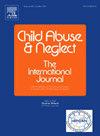证实儿童虐待的家庭背景和照顾者特征:报告水平分析
IF 3.4
2区 心理学
Q1 FAMILY STUDIES
引用次数: 0
摘要
儿童虐待是一个主要的公共卫生问题,往往影响到同一家庭中的多个儿童,受到共同家庭动态的影响。然而,研究主要集中在个别儿童身上,忽视了在共同家庭背景下兄弟姐妹之间的虐待模式。目的:本研究采用家庭层面的方法,对儿童保护服务(CPS)报告中的所有儿童进行分析,研究与证实的儿童虐待相关的家庭和肇事者特征。该研究分析了2018年和2019财政年度来自美国21个州的440,754份经证实或有根据的CPS报告。方法使用国家儿童虐待和忽视数据系统(NCANDS),我们根据所有儿童被证实的虐待类型将报告分为四个相互排斥的组:仅忽视,忽视他人,仅虐待和虐待他人(不包括忽视)。描述性分析通过家庭特征、犯罪者属性以及家庭规模和犯罪模式的交集来比较这些群体。结果超过一半(51.3%)的报告涉及多名儿童,证实结果混合。仅被忽视的案件(58.5%),主要涉及非常年幼的儿童、具有照顾角色的女性施暴者以及先前的施暴史。仅虐待案件(14.0%)通常涉及年龄较大的儿童、单独施暴者和非照顾者角色的男性。多种虐待类型的报告反映了有多个施暴者的复杂家庭动态。结论小规模治疗通常涉及一个家庭中的多个儿童,其模式受复杂的家庭动态影响,因此需要量身定制、以家庭为中心的干预措施。本文章由计算机程序翻译,如有差异,请以英文原文为准。
Family context and caregiver characteristics in substantiated child maltreatment: A report-level analysis
Background
Child maltreatment is a major public health concern often affecting multiple children in the same household, shaped by shared family dynamics. Yet research has primarily focused on individual children, overlooking patterns of maltreatment across siblings in a shared family context.
Objective
This study examined household and perpetrator characteristics associated with substantiated child maltreatment using a family-level approach that analyzed all children within Child Protective Services (CPS) reports.
Participants and setting
The study analyzed 440,754 substantiated or indicated CPS reports from 21 U.S. states during fiscal years 2018 and 2019.
Methods
Using the National Child Abuse and Neglect Data System (NCANDS), we categorized reports into four mutually exclusive groups based on the types of substantiated maltreatment across all children: neglect only, neglect with other, abuse only, and abuse with other (excluding neglect). Descriptive analyses compared these groups by family characteristics, perpetrator attributes, and the intersection of family size and perpetration pattern.
Results
More than half of reports (51.3 %) involved multiple children with mixed substantiation outcomes. Neglect only cases (58.5 %), predominantly involved very young children, female perpetrators with caregiving roles, and prior perpetration history. Abuse only cases (14.0 %) typically involved older children, sole perpetrators, and males in non-caregiver roles. Reports with multiple maltreatment types reflected complex family dynamics with multiple perpetrators.
Conclusions
Maltreatment often involves multiple children in a household, with patterns shaped by complex family dynamics, highlighting the need for tailored, family-centered interventions.
求助全文
通过发布文献求助,成功后即可免费获取论文全文。
去求助
来源期刊

Child Abuse & Neglect
Multiple-
CiteScore
7.40
自引率
10.40%
发文量
397
期刊介绍:
Official Publication of the International Society for Prevention of Child Abuse and Neglect. Child Abuse & Neglect The International Journal, provides an international, multidisciplinary forum on all aspects of child abuse and neglect, with special emphasis on prevention and treatment; the scope extends further to all those aspects of life which either favor or hinder child development. While contributions will primarily be from the fields of psychology, psychiatry, social work, medicine, nursing, law enforcement, legislature, education, and anthropology, the Journal encourages the concerned lay individual and child-oriented advocate organizations to contribute.
 求助内容:
求助内容: 应助结果提醒方式:
应助结果提醒方式:


